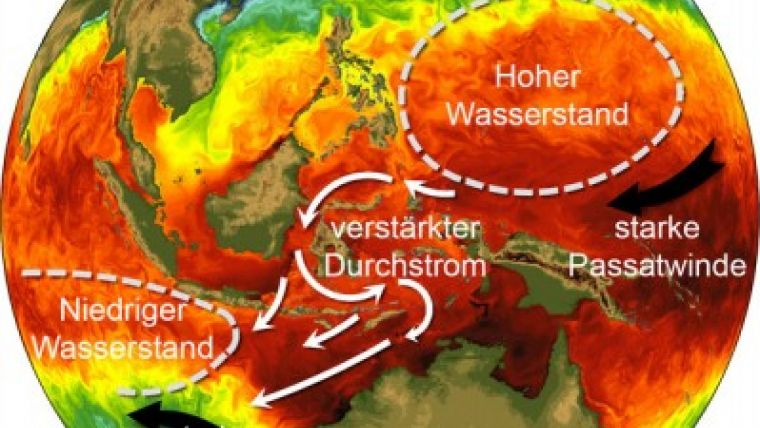Indian Ocean Hides Global Warming
A team of scientists from both the US and the German GEOMAR Helmholtz Centre for Ocean Research Kiel have demonstrated that the heat content of the Indian Ocean has risen substantially since the late 1990s, even though the global temperature showed only minor changes in the same period. This increase is very likely caused by a higher heat transfer from the Pacific to the Indian Ocean, as the authors report in the international scientific journal Nature Geoscience.
Although the emissions of greenhouse gases continued to rise steadily, global warming seems to have paused unexpectedly at the end of the 20th and the beginning of the 21st century. In a recent study that used observational data as well as model results researchers were able to show that the Indian Ocean has stored much more heat in the past two decades than in previous times. A large fraction of the heat has been transferred from the Tropical Pacific via the Indo-Pacific Archipelago into this part of the world ocean.
Initially the hypothesis was that above average heat was stored in the Pacific, according to Dr. Wonsun Park, co-author from GEOMAR Helmholtz Centre for Ocean Research Kiel. The researchers had to reject this hypothesis because observed hydrographic data showed a decline of the heat content in the Pacific. Thus, lead author Dr. Sang-Ki Lee from University of Miami and NOAA AOML conducted a series of comprehensive model studies. With these results Sang-Ki Lee and Wonsun Park were able to come up with a conclusive mechanism to explain the pause of global warming.
In the Indo-Pacific region the past two decades were characterised by enhanced “La Niña-like” conditions with cold waters in the Eastern Pacific and warm waters in the Western Pacific. Driven by the enhanced trade wind system, warm water was moved westward by the Indonesian throughflow into the Indian Ocean. Finally, about 70% of the global heat uptake is stored in the upper 700 metres of the Indian Ocean.
The results of this study underpin the importance of the Indonesian throughflow as an important part of the global (thermohaline) circulation, according to Mrs Sang-Ki Lee. The accumulated heat could be redistributed globally by other ocean currents such as the Agulhas current and finally may reach the Atlantic. At present stage, it is unknown which climate variations might be affected due to this redistribution of heat. This phenomenon will be observed and the researchers are to conduct further model studies.
Original publication: Lee, S.-K., W. Park, M. O. Baringer, A. L. Gordon, B. Huber and Y. Liu, 2015: Pacific origin of the abrupt increase in Indian Ocean heat content during the warming hiatus. Nature Geoscience, doi:10.1038/ngeo2438.
Image: Schematic diagram of sea surface height changes and the Indonesian throughflow in the past 20 years. Background: sea surface temperature. Image courtesy: NOAA.

Value staying current with hydrography?
Stay on the map with our expertly curated newsletters.
We provide educational insights, industry updates, and inspiring stories from the world of hydrography to help you learn, grow, and navigate your field with confidence. Don't miss out - subscribe today and ensure you're always informed, educated, and inspired by the latest in hydrographic technology and research.
Choose your newsletter(s)
























